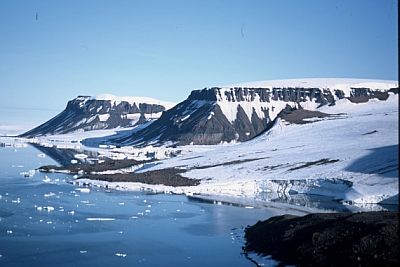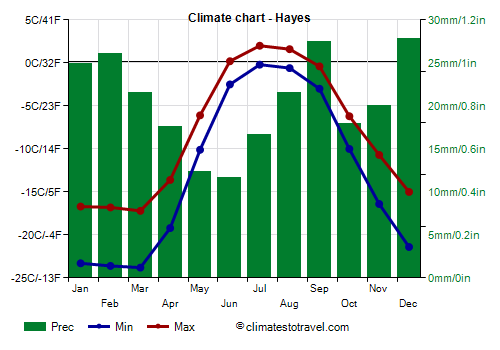Select units of measurement for the temperature and rainfall tables (metric or imperial).
Average weather, temperature, rainfall, sunshine hours
Franz Josef Land has a
polar climate, with temperatures below freezing for most of the year, and around freezing in summer.
Franz Josef Land is located north of Russia, between the Arctic Ocean and the Barents Sea. The archipelago, discovered in 1873 by Austrian explorers and now belonging to Russia, is made up of 191 islands, for a total of 16,100 square kilometers (6,215 square miles), inhabited only by military personnel and research expeditions. About 350 kilometers (190 miles) to the west are the Svalbard Islands, belonging to Norway.

Franz Josef Land is the most northeastern area of Europe, and is also home to the
northernmost point of Europe (Cape Fligely, at almost 82 degrees north latitude, and 910 kilometers or 565 miles from the Pole), so even further north than Svalbard, whose northern part is at the same latitude as the southern part of this archipelago.
The islands are occupied by hills, whose highest point is 620 meters (2,034 feet), and are largely
covered by ice, approximately above 100 meters (330 ft) above sea level, although there are some flat areas where in summer the snow melts, and moss and lichens form.
The climate of Franz Josef Land is colder than that of Svalbard, which are located in the area where the last branch of the Gulf Stream arrives. However, this archipelago can also be affected by mild air masses from the Atlantic.
The
sea is frozen for most of the year, while from July to September or October the sea ice retreats, especially in the western and southern parts of the archipelago. For this reason, access by sea is possible only in summer. However, the extent of the ice varies from year to year.
The
wind blows often and with considerable intensity, although it decreases a bit from May to September.
In summer,
fog can form.

On
Hayes Island (also called Heiss,
Ostrov Kheysa in Russian), the
average temperature ranges from about -20 °C (-4 °F) from January to March to about 1 °C (34 °F) in July.
During
cold waves, the temperature drops below -30 °C (-22 °F) almost every year. In the past, it has also dropped below -40 °C (-40 °F), although this has not happened for several years. The coldest record is -44.4 °C (-47.9 °F), recorded in February 1978.
On
milder days, temperatures typically reach around 0 °C (32 °F) in May and October, and are above freezing from June to September. The warmest record is 10 °C (50 °F), reached in August 2023 and July 2024.
Here are the average temperatures.
Hayes - Average temperatures (1991-2020) |
| Month | Min | Max | Mean |
|---|
| January | -23.3 | -16.7 | -20 |
|---|
| February | -23.6 | -16.8 | -20.2 |
|---|
| March | -23.8 | -17.2 | -20.5 |
|---|
| April | -19.2 | -13.6 | -16.4 |
|---|
| May | -10.1 | -6.1 | -8.1 |
|---|
| June | -2.5 | 0.2 | -1.2 |
|---|
| July | -0.2 | 2 | 0.9 |
|---|
| August | -0.6 | 1.6 | 0.5 |
|---|
| September | -3 | -0.4 | -1.7 |
|---|
| October | -10 | -6.2 | -8.1 |
|---|
| November | -16.4 | -10.7 | -13.6 |
|---|
| December | -21.4 | -15 | -18.2 |
|---|
| Year | -12.8 | -8.2 | -10.45 |
|---|
is scarce, around 270 mm (10.5 inches) per year. It occurs as snow for most of the year, while from June to September, and sometimes in late May and early October, it can also occur as rain.
Here is the average precipitation.
Hayes - Average precipitation| Month | Days |
|---|
| January | 29 | 7 |
|---|
| February | 32 | 5 |
|---|
| March | 21 | 4 |
|---|
| April | 19 | 4 |
|---|
| May | 12 | 3 |
|---|
| June | 11 | 3 |
|---|
| July | 18 | 5 |
|---|
| August | 21 | 6 |
|---|
| September | 23 | 6 |
|---|
| October | 19 | 6 |
|---|
| November | 26 | 7 |
|---|
| December | 42 | 7 |
|---|
| Year | 275 | 64 |
|---|
The
sun shines rarely, about 1,000 hours per year, with a maximum from April to June. Given the latitude, the sun is always below the horizon from late October to late February, while it never sets from mid-April to late August. Here are the average hours of sunshine per day.
Hayes - Sunshine hours| Month | Average | Total |
|---|
| January | 0 | 0 |
|---|
| February | 0 | 0 |
|---|
| March | 2 | 65 |
|---|
| April | 8 | 235 |
|---|
| May | 7.5 | 225 |
|---|
| June | 6.5 | 195 |
|---|
| July | 5.5 | 170 |
|---|
| August | 2.5 | 85 |
|---|
| September | 1 | 30 |
|---|
| October | 0 | 0 |
|---|
| November | 0 | 0 |
|---|
| December | 0 | 0 |
|---|
| Year | 2.8 | 1005 |
|---|